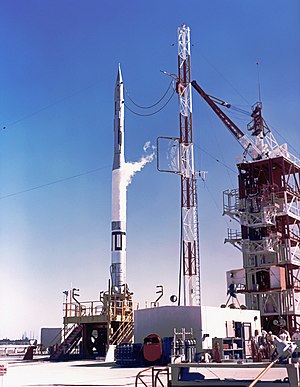 Vanguard rocket on LC-18A prior to its launch | |
| Names | Vanguard Space Launch Vehicle-Six |
|---|---|
| Mission type | Solar heating of Earth |
| Operator | Naval Research Laboratory |
| Mission duration | Failed to orbit |
| Spacecraft properties | |
| Spacecraft | Vanguard 3B |
| Spacecraft type | Vanguard |
| Manufacturer | Naval Research Laboratory |
| Launch mass | 10.8 kg (24 lb) |
| Dimensions | 50.8 cm (20.0 in) of diameter |
| Start of mission | |
| Launch date | 22 June 1959, 20:16:09 GMT |
| Rocket | Vanguard SLV-6 |
| Launch site | Cape Canaveral, LC-18A |
| Contractor | Glenn L. Martin Company |
| End of mission | |
| Decay date | Failed to orbit |
| Orbital parameters | |
| Reference system | Geocentric orbit (planned) |
| Regime | Medium Earth orbit |
| Perigee altitude | 655 km |
| Apogee altitude | 3840 km |
| Inclination | 34.20° |
| Period | 134.0 minutes |
Vanguard SLV-6, also called Vanguard Satellite Launch Vehicle-Six, hoped to be the third successful flight of the American Vanguard rocket following the successful Vanguard 2 satellite on rocket Vanguard SLV-4. Vanguard Satellite Launch Vehicle-6 (SLV-6) was designed to carry a small spherical satellite into Earth orbit to study solar heating of Earth and the heat balance. A faulty second stage pressure valve caused a mission failure.